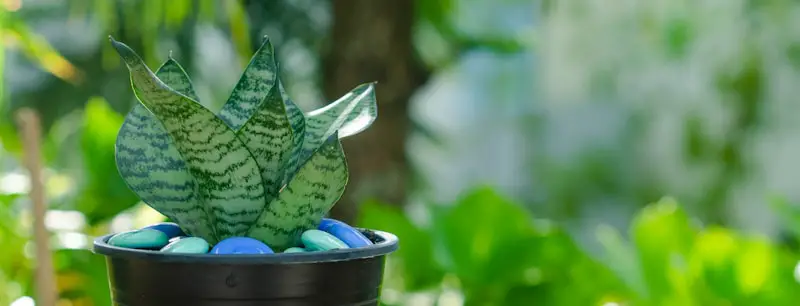This beginner’s guide provides all you know about propagating snake plants. That includes propagation with water and soil cuttings. If you like taking care of snake plants, read below for more!
Snake plants are an ideal plant choice for indoor propagation. Snake plant propagation is straightforward, and there are five common ways you can do so. You can use rhizome, division, cuttings placed in well-draining soil, rooting cuttings in water, and leaf cuttings within LECA.
Figuring out the different propagation methods and deciding which one is best for you can be tricky. In this blog, we discuss various ways to propagate snake plants so that you can determine what method suits you best.

How To Propagate Snake Plants
Snake plants are gorgeous indoor plants, but beginners might worry about how to grow and propagate them. It’s cheaper and easier to reproduce, so you should know what methods work for the plant and which ones you can carry out yourself. Below are the most common ways to propagate snake plants:
1. Rhizome Cuttings
One method to propagate snake plants is via rhizome. These white root-like stalk forms link the parent plant to its newborn babies. The rhizomes scatter either above or below the soil and grow new plants. It’s rare to find a rhizome sprout above the ground in many potted plants.
To grow snake plants via its rhizome, use a sterile knife to trim the rhizome from the snake plant. Ensure you circumvent the roots, although it isn’t a massive issue if you cut a few of them since it’s a hardy plant!
Allow the rhizome to dry for 24 hours, and then sow it to help the trimmed section harden over to maintain better water intake. Maintain the newly planted rhizome cutting’s moisture for weeks until you observe new growth!
2. Division
If you own a sizable snake plant, the ideal way to propagate it is via division. That is akin to multiplying it via rhizome and is the method many people use for large indoor snake plants.
While the snake plant is beautiful, it can get quite sizable, especially indoors. So, some of the internal leaves end up not doing so well. In that case, it’s best to divide the plant. You can take the whole plant and keep it on a tarp in the living room. Then, brush off the soil, and look for any large rhizomes linked to the plant.
Can Snake Plants Have Babies?
True! Snake plants can have babies. That is why you can propagate them via division. The primary plant sprouts rhizomes, eventually growing and becoming new snake plants.
The ideal practice is to be patient for the first few days while the freshly cut roots start hardening. But you may not want dirt everywhere on your floor for those first few days. So, you can re-pot half the plant in one container while the other half goes in another one! That way, both plants propagate well.
3. Water
Water propagation is a standard method for most plants. It’s cheap, easy, and requires the least amount of monitoring. It’s also the most straightforward if you can prevent rot. Still, it generally takes the most time, so you require much patience with it.
Most people prefer to propagate snake plants by rooting cuttings in water if the plant has a limp leaf that you need to trim. It’s better to grow a new plant with the poor leaf instead of just wasting it.
Can You Cut The Leaves Off A Snake Plant?
That’s possible! Pruning is frequently essential for most indoor plants. But occasionally, snake plants can have leaves that grow oddly. In that case, you can cut the leave-off close to the ground—just underneath the soil line, if you can—and place it in water. Vases and Mason jars are excellent picks, mainly because the cuttings can occasionally be top-heavy.
Keep the cuttings in indirect light and alter the water weekly or so when you water your plants. You can relocate your cutting when the roots start to sprout. Keep in mind that this propagation method can take a while!
(Note: you can cut pieces and stick them back into some soil to carry out a test. The cuttings not only live but flourish and blend perfectly with the plant you add them to.)
You can let the plant propagate for eight months while ignoring it, never monitoring it, and seldom adding adequate water. And one day, you can see that you’re growing a new snake plant in the water.
When your leaf cutting grows roots, you can sow it in the ground and keep the dirt damp. Hold back on the watering when you softly pull on the leaf-cutting and feel some resistance. It means the cutting is beginning to grow roots, and you can see new growth budding soon.
4. LECA
You can say that infrequently attempting to grow the leaf cuttings of a snake plant can cause rot. If you can’t see roots after numerous weeks and the base of your leaves is starting to turn brown and limp, water propagation might not be the ideal method. These issues commonly happen with the whale fin snake plant, called masoniana, if you try to root its leaf cuttings in water.
So, you can try LECA instead. And what is LECA? In short, they are clay balls that retain moistness. Many people experiment extensively with propagating cuttings in LECA nowadays, so using this propagation method for whale fin leaf cuttings is an ideal option.
To propagate snake plants in LECA, rinse the LECA meticulously and make a layer in the bottom of a container. Then place the leaf-cutting inside and surround the cuttings with more LECA for stability. Fill water into the bottom of the container—just enough to make a basin. The water shouldn’t be able to reach the underside of the cutting.

5. Soil
You can also propagate snake plants in soil with one leaf cutting. So, the ground is another excellent propagation method if water or LECA propagation doesn’t work for you! To propagate snake plants in the soil with leaf cuttings, trim a leaf off your snake plant near the dirt line. Then cut that leaf into tinier sections a few inches in length.
Note: it’s essential to track which end was the bottom! They won’t grow if you put the top back down in the soil. Just keep them in line on a table.
Allow the cut leaf to grow for a few days, then fix each cutting with the base end to drain the soil properly. They start to root, although it may take a month or so for the roots to grow and then an additional month to see new leaf growth. Like water propagation, this method requires patience since it takes time.
Nothing is visible under the soil’s surface, so it can feel like the propagation is taking forever. The roots need to grow, and the babies need to grow too. The new plants eventually start to sprout their roots above the soil line. Yes, it can take a long time, but it’s an affordable way to propagate snake plants.
Final Words
That’s about it. Now that you know how to propagate snake plants, you should be able to fill each room in your home with snake plants with ease! These plants are some people’s favorites, so growing them can be near and dear to their hearts. So, we hope you can now propagate your snake plants! Good luck!
Victoria is the owner and main author of hobby plants. She loves spending her free time in her garden planting and taking care of her plants. Victoria hopes you enjoy the content here!
![How To Propagate Prayer Plant? [COMPLETE BEGINNER'S GUIDE] How To Propagate Prayer Plant? [COMPLETE BEGINNER'S GUIDE]](https://www.hobbyplants.com/wp-content/uploads/2022/07/how-to-propagate-prayer-plant-300x158.jpg)
![How To Propagate A String Of Hearts? [BEGINNER'S GUIDE] How To Propagate A String Of Hearts? [BEGINNER'S GUIDE]](https://www.hobbyplants.com/wp-content/uploads/2022/07/how-to-propagate-string-of-hearts-300x158.jpg)
![How To Propagate Wandering Jew? [COMPLETE BEGINNER'S GUIDE] How To Propagate Wandering Jew? [COMPLETE BEGINNER'S GUIDE]](https://www.hobbyplants.com/wp-content/uploads/2022/07/how-to-propagate-wandering-jew-300x158.jpg)
![How To Propagate Pothos? [COMPLETE BEGINNER'S GUIDE] How To Propagate Pothos? [COMPLETE BEGINNER'S GUIDE]](https://www.hobbyplants.com/wp-content/uploads/2022/07/how-to-propagate-pothos-300x158.jpg)
![How to Repot A Snake Plant? [STEP BY STEP GUIDE] How to Repot A Snake Plant? [STEP BY STEP GUIDE]](https://www.hobbyplants.com/wp-content/uploads/2022/08/how-to-repot-snake-plant-300x158.jpg)
![Can Snake Plants Live Outside? [COMPLETE CARE GUIDE] Can Snake Plants Live Outside? [COMPLETE CARE GUIDE]](https://www.hobbyplants.com/wp-content/uploads/2022/08/can-snake-plants-live-outside-300x158.jpg)

![How Often Do You Water A Snake Plant? [FIND OUT HERE] How Often Do You Water A Snake Plant? [FIND OUT HERE]](https://www.hobbyplants.com/wp-content/uploads/2022/07/how-often-do-you-water-a-snake-plant-1-300x158.jpg)


![How Do You Propagate a Money Tree? [COMPLETE GUIDE] How Do You Propagate a Money Tree? [COMPLETE GUIDE]](https://www.hobbyplants.com/wp-content/uploads/2022/06/how-to-propagate-money-tree-300x158.jpg)
![How to Propagate Fiddle Leaf Fig [BEST METHODS] How to Propagate Fiddle Leaf Fig [BEST METHODS]](https://www.hobbyplants.com/wp-content/uploads/2022/06/how-to-propagate-fiddle-leaf-fig-300x158.jpg)
